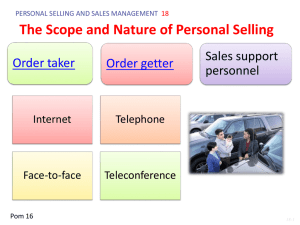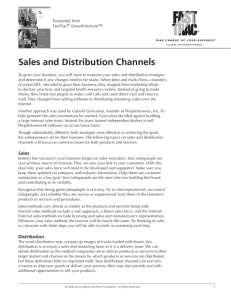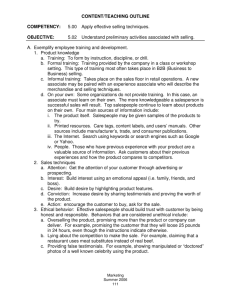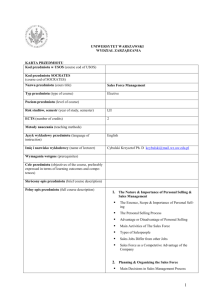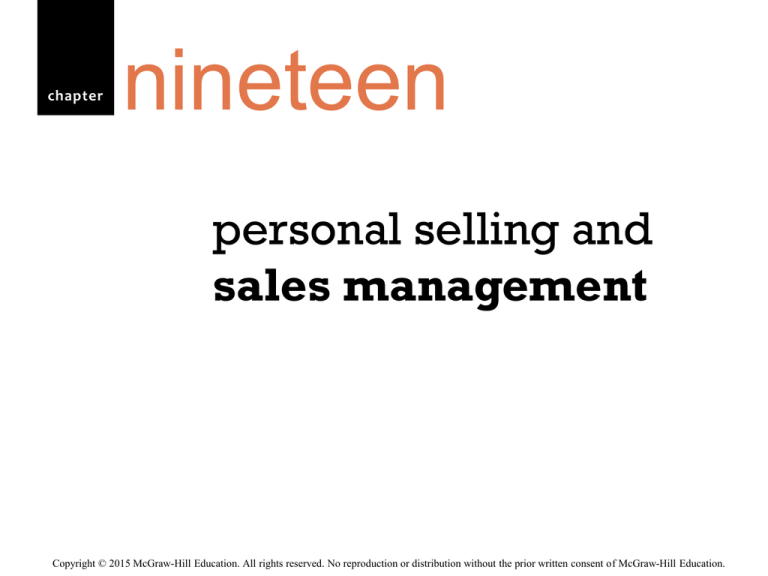
chapter
nineteen
personal selling and
sales management
Copyright © 2015 McGraw-Hill Education. All rights reserved. No reproduction or distribution without the prior written consent of McGraw-Hill Education.
LEARNING OBJECTIVES
LO 19-1 Describe the value added of personal selling.
LO 19-2 Define the steps in the personal selling
process.
LO 19-3 Describe the key functions involved in
managing a sales force.
LO 19-4 Describe the ethical and legal issues in
personal selling.
19-2
The Scope and Nature of Personal
Selling
Internet
Telephone
Face-to-face
Teleconference
19-3
Professional Selling as a Career
• People love the lifestyle
• There is a lot of flexibility
• There is a lot of variety in
the job
• Can be very lucrative
• Very visible to
management and good
for promotions
©Royalty-Free/Corbis
Sales Jobs Website
19-4
The Value Added by Personal Selling
• Salespeople Provide
Information and
Advice
• Salespeople Save
Time and Simplify
Buying
• Salespeople Build
Relationships
©Royalty-Free/Corbis
19-5
The Personal Selling Process
Generate and
qualify leads
Preapproach
Closing the sale
Follow-up
Sales presentation
and overcoming
reservations
19-6
Step 1: Generate and Qualify Leads
Current
Customers
Trade
Shows
Sources of
Leads
Networking
Events
The
Internet
19-7
Generate Leads
Cold calls
Telemarketing
©Royalty-Free/Corbis
19-8
Step 2: Preapproach
Extends the
qualification
procedure
Set goals for what is
to be accomplished
©Royalty-Free/Corbis
19-9
Step 3: Sales Presentation
and Overcoming Reservations
The Presentation
Handling Reservations
Klaus Tiedge/Blend Images/Getty Images
19-10
Aligning the Personal Selling Process
with the B2B Buying Process
Personal selling process
B2B buying process
Generate and qualify leads
Need recognition
Product specification
Preapproach
RFP process
Sales presentation and
overcoming reservations
Proposal analysis
and supplier selection
Closing the sale
Order specification
Follow-up
Performance assessment
19-11
Digital Vision/Getty Images
Step 4: Closing the Sale
• Getting the order
• Often most stressful
part of sales process
• A “no” one day may
be the foundation for
a “yes” another
19-12
Step 5: Follow-Up
Five Service Quality Dimensions
Reliability
Responsiveness
Assurance
Empathy
Tangibles
19-13
check yourself
1. Why is personal selling important to an IMC
strategy?
2. What are the steps in the personal selling
process?
19-14
Managing the Sales Force
Sales training
Motivating
and
compensating
salespeople
Recruiting and
selecting
salespeople
Sales force
structure
Managing
the Sales
Force
Evaluating
salespeople
19-15
Sales Force Structure
Company
sales force
Manufacturers
representatives
(independent agents)
Employees
Not employees
Established product lines
Smaller firms
New markets
19-16
Salesperson Duties
Order getter
Order taker
Comstock Images /Jupiter images.
Sales support personnel
19-17
Recruiting and Selecting Salespeople
Personality
Empathy
Selfmotivation
Optimism
Resilience
19-18
Recruiting for Success
How does a firm
that focuses on a
fun product
recruit
salespeople who
exhibit fun?
©Stockbyte/PunchStock
19-19
Sales Training
Selling and negotiation techniques
Products and service knowledge
Technologies used in the selling process
Time and territory management
Company policies and procedures
19-20
Motivating and Compensating
Salespeople
GRANTLAND® Copyright Grantland Enterprises; www.grantland.net
Financial rewards
Nonfinancial rewards
19-21
Evaluating Salespeople
• Tied to the reward
structure
• Evaluation measures
can be either objective
or subjective
BananaStock/PictureQuest
19-22
check yourself
1. What do sales managers need to do to
successfully manage their sales force?
2. What is the difference between monetary
and nonmonetary incentives?
19-23
Ethical and Legal Issues in
Personal Selling
The Sales
Manager and the
Sales Force
The Sales Force
and Corporate
Policy
The Salesperson
and the
Customer
19-24
check yourself
1. What are three areas of personal selling in
which ethical and legal issues are more likely
to arise?
19-25

